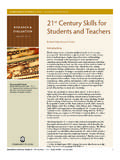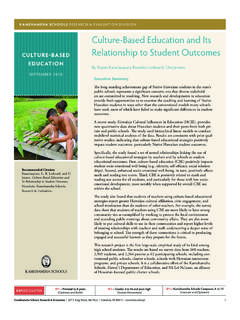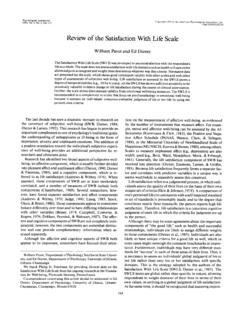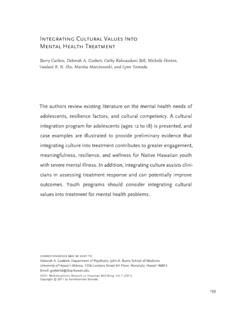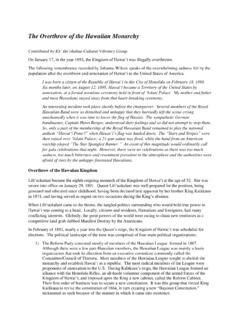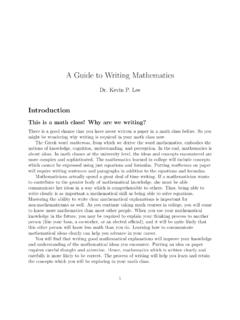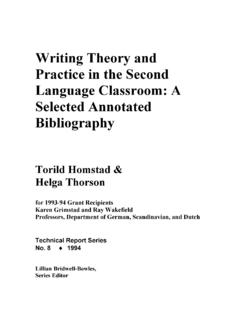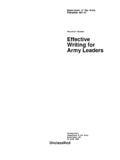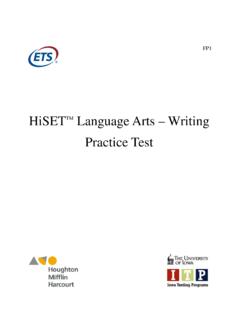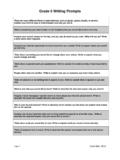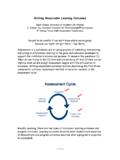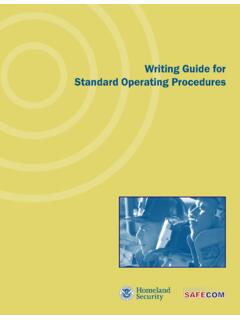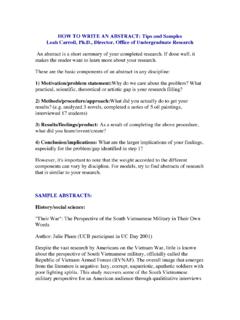Transcription of THE WRITING PROCESS - Kamehameha Schools
1 THE WRITING PROCESS : An Overview of Research on Teaching WRITING as a PROCESS April 2007. RESEARCH & EVALUATION REPORT. ESPEEDOMETER. Purpose of Our Study How does this report relate to Kamehameha Schools ' Contemporary literacy theory argues that teaching students how to Education Strategic Plan (ESP)? write is a means to more fully engage them as readers and in literacy STRATEGIC PRIORITIES learning. The WRITING PROCESS is utilized in many classrooms. This method emphasizes the recursive processes of prewriting, draft- Optimize and Build ing, editing, and revising. The purpose of this study reviews research (Prenatal 8). Sustain Momentum about the evolution and effectiveness of the WRITING PROCESS . (Grades 4 16 & post-high). Innovate and Optimize What We Learned (KS K 12 campuses). Based on research, WRITING instruction has moved from focusing on spelling, grammar, and other WRITING conventions, to a holistic view emphasizing WRITING as a recursive PROCESS .
2 Specifically, research shows a direct correlation between instruc- tion based on WRITING PROCESS techniques and students' WRITING proficiency level. Copyright by Kamehameha Schools 2007. Pre- WRITING is essential to producing quality WRITING . Research in- All rights reserved. This publication is also dicates that skilled writers spend significantly more time organizing available online at and planning what they are going to write. Published by the Research & Evaluation department of Kamehameha Schools Teaching WRITING through inquiry also helps students improve in 567 South King Street, Suite 400 statistically significant ways. Honolulu, Hawai i 96813. Tel: (808) 541-5372. Implications More large-scale research studies are needed; however current substantial evidence documents the benefits of the WRITING PROCESS on students' WRITING . Teaching students to use one or two stages of the WRITING PROCESS enhances their WRITING abilities significantly. Findings provide a compelling rationale for using the WRITING pro- cess as a method of instruction in the classroom.
3 Teaching Literacy through WRITING : An Overview of Research on Teaching WRITING as a PROCESS Introduction In today's society, the act of WRITING is ingrained in every aspect of our lives and will continue to shape human interaction as we head full force into the 21st century. The ability to write articulately gives one the power and opportunity to share and influence thoughts, ideas, and opinions with others, not only in day-to-day situations, but across time and space. As Mary Heller writes, The value that we place on reading and WRITING arises out of our shared need to be literate people, this is a function of our society and of our culture (1991, ). As writers, it is important to produce quality works, and as educators, we have learned a great deal about what it means to teach others to do the same. This brief offers an overview of research and best practice in teaching the WRITING PROCESS . Teaching WRITING : Grammar versus Content and Style Contemporary literacy theory argues that teaching students how to write is a means to more fully engage them in literacy learning.
4 However, this was not always the case. Fifty years ago, WRITING was taught via the technical aspects of proper grammar, spelling, punctuation, and other conventions. Grammar instruction, or essentially how the English language works, was thought to be essential to learning how to write and therefore, a principal focus in teaching WRITING (Hillocks, 1987). Eventually, this rote approach came under increasing skepticism because it failed to engage and inspire student learning (Hicks, 1993; Hillocks, 1986). Since then, research has helped identify more effective ways to improve the quality of WRITING . An early review of the literature found that teaching and studying grammar had no effect on the quality of one's WRITING (Braddock, Lloyd-Jones, & Schoer, 1963). This conclusion was further supported by a carefully designed three year study in New Zealand. The study examined the effects of exposing randomly assigned students to intensive grammar instruction taking up the major part of the day compared to a control group of other students who did not have the treatment ( Elley, Barham, Lamb, & Wyllie 1976).
5 At the conclusion of the study, researchers found no statistically significant differences in WRITING quality between the grammar-focused treatment groups and the no-grammar treatment groups. Further support of these findings emerged in an exhaustive research review by Hillocks (1987). After reviewing thousands of studies, the author concluded that studying grammar does not increase WRITING quality. He argues that these findings are not unexpected because, although knowledge of grammar is important to proper WRITING , the way that content is produced is not dependent upon correct grammar, but is more of an intuitive PROCESS . Furthermore, grammar is corrected, changed and accounted for during the editing or proofreading stages of the WRITING PROCESS , two stages believed to have little or no influence on the content or style of WRITING (National Center for Educational Statistics, 1996). Subsequent research shows that skilled writers focus more on content and organization, whereas less experienced writers are more concerned with WRITING mechanics such as spelling or diction (Hillocks, 1986).
6 1. The WRITING PROCESS Today WRITING instruction began to change throughout the United States as teachers found more holistic approaches to teaching WRITING (McCarthey, Hoffman, Stable, Elliott, Dressman, & Abbott, 1994). Responding to the need for innovative instruction and pedagogies, the last two decades saw an emergence of new practices that moved beyond rote repetition and technical instruction. Instead, WRITING was taught as a vehicle for creative expression and critical thought. Rather than focusing on spelling, grammar, and other WRITING conventions, the holistic PROCESS emphasizes the actual PROCESS of WRITING . It concentrates on WRITING as a recursive PROCESS in which writers have the opportunity to plan, draft, edit, and revise their work (Hillocks, 1987; Murray, 1982). The writer is taught to review and revise several drafts, which enables and encourages new ideas. Grammatical changes and conventional editing occur during the revision or editing stage (Ballator, Farnum, &.)
7 Kaplan, 1999; Flower & Hayes, 1981). Furthermore, since grammar and conventions are not the focus of WRITING , the WRITING PROCESS may be adapted for use even with young writers in kindergarten (Sealey, Sealey, & Millmore, 1979). WRITING is a uniquely individual undertaking and the same individual may use different methods to express him or herself. Characteristically, the WRITING PROCESS approach recognizes that there are many stages to WRITING and that these stages are fluid and overlapping (Bereiter & Scardamalia, 1983; Flower & Hayes, 1980; Murray, 1982). However, researchers and educators have identified several logical steps that most writers go through, displayed in Figure 1. Figure 1. The WRITING Process1. Pre- WRITING Drafting & Sharing & Revising & Publishing WRITING Responding Editing - Getting ready -Write and -Share work to -Revise content -Celebrate and to write refine gain feedback -Proofread for showcase -Decide on a paragraphs -Peer editing WRITING finished topic -Focus on - WRITING conventions products -Brainstorm communication Workshops -Text -Build -Organize ideas of meaning reorganization confidence in students as writers Existing Research about the WRITING PROCESS Longitudinal brain research using neural imaging techniques demonstrates that whereas speech is a very natural developmental PROCESS in human cognition, reading and WRITING require specific training to achieve sophisticated development (Pugh et al.
8 , 2000). Studies to date indicate that the WRITING PROCESS is one effective way to teach students to be good writers. (Flower & Hayes, 1981;. Greenwald, Persky, Campbell, & Mazzeo, 1999; Unger & Fleischman, 2004; National Center for Education Statistics, 1996). Students are taught how to share and communicate their ideas through 1. Based upon research by Graves, 1983, 1991; Tompkins and Hoskisson, 1995; and Poindexter and Oliver, 1999. 2. words. In some classrooms, they share their work with peers through WRITING workshops and peer editing, teaching them to recognize the value of WRITING and the purpose in creating a solid and substantial work (Graves, 1983). Pre- WRITING Pre- WRITING , or planning out what is going to be written, is an essential step in the WRITING PROCESS and should account for 70 percent of the WRITING time (Murray, 1982). Research indicates that skilled writers spend significantly more time organizing and planning what they are going to write (Hillocks, 1986).
9 Most students, however, spend on average only about 3 minutes to prepare for their WRITING (National Center for Educational Statistics, 1996). Students spend little time thinking and planning how to express their thoughts before WRITING them down and therefore are not accessing information and ideas that could possibly enhance their WRITING . Re- WRITING An important component to the WRITING PROCESS is its recursive nature, which allows writers to revise their work continually. Evidence shows that writers not only revise what they are WRITING , but also revisit their goals and plans for WRITING . This PROCESS allows writers to take into account new ideas and thoughts and to have the opportunity to incorporate it into their WRITING . Research by Bereiter et al. (1982) demonstrates that the processes involved in WRITING are hierarchically related and notably recursive. The research team also found that children have much more extensive knowledge about a topic than that reflected in their typical writings.
10 They argue that when children stop WRITING it is not because they run out of things to say, but because they do not yet have adequate methods of articulating what they know. This research informs how we teach WRITING , because by allowing students to write and rewrite, we are helping them learn how to tap into their knowledge WRITING As methods of teaching WRITING have evolved, significant research has gone into understanding the PROCESS that a writer goes through when composing material and how to teach WRITING most effectively. In an effort to synthesize the findings, one comprehensive review looked at 2,000 studies focused on identifying school instructional methods that most successfully enhanced WRITING ability (Hillock, 1987). Several hundred of these studies used experimental treatments and interventions. After rigorous screening, meta-analysis was conducted on 60 of the latter studies containing variables that could be compared across studies. The meta-analysis revealed that teaching through inquiry was the instructional method with the greatest impact on the quality of students WRITING (see Figure 22).
